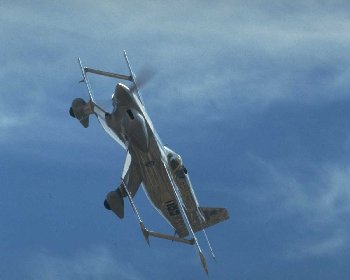Retractable Landing Gear
Today, we write a rule for choosing retractable landing gear. The University of Houston's College of Engineering presents this series about the machines that make our civilization run, and the people whose ingenuity created them.
The first retractable landing gears showed up on airplanes just after WW-I. They didn't become a common currency of flight until the mid-1930s. Walter Vincenti asks about their evolution:
You're an airplane designer. How do you decide whether or not to make the landing gear retract? What questions do you ask?
First you weigh the drag force on wheels and struts moving through air against the cost and weight of retraction machinery. Then other issues arise: maintenance, reliability, wheel storage space, power requirements. And style! Don't forget style.
Most WW-I planes had fixed wheels on a common axle held by struts. After the war, we held each wheel on its own tripod of struts. We also began experimenting with retractable gear. By 1930 Boeing and Lockheed had made commercial planes with retractable wheels. Jack Northrup had also experimented with retraction, but he loved streamlining. He cooked up an alternative.
Northrup shaped cowls around vertical struts holding each wheel. He called those cowls trousers. The bottoms of the wheels look like dainty little shoes at the end of bell-bottom trousers. Other makers followed his lead. Amelia Earhart and Wiley Post set records with planes whose wheels were cased in teardrop spats.
Cowls on fixed landing gear worked pretty well. A cowl might reduce airspeed only four percent. Then the wing had to be a bit larger to carry the weight of the cowl. At speeds under 200 mph, a little clumsiness bought a lot of simplicity and economy.
One big problem with retractable gear was the power needed to move it. The early ones were hand-cranked. Next they were driven by heavy electric motors. Then, in 1937, the O-ring appeared. With O-rings, simple hydraulic systems became practical for retracting wheels. The last airplane to win the Thompson Trophy wearing pants did it a year later. After that, the rule for choosing fixed or retractable wheels was set.
Ever since WW-II, the rule has been fixed wheels for light planes flying less than 200 mph; retractable gear for fast commercial and combat planes. Streamlined cowls turned into a useless middle ground. Northrup was one of the last to agree. Did he hold out too long? Vincenti's study suggests something else.
The people who pushed cowled wheels gave us a point of reference. Northrup's love of streamlining drove him to take fixed wheels as far as they could go, and that drove learning. Hanging on to those wild evocative cowls was a basic step toward leaving them behind. That is a fact of technological change.
We really had to fully plumb the exception to retractable wheels -- the Art Deco wheel cowl -- to finally prove the rule.
I'm John Lienhard, at the University of Houston, where we're interested in the way inventive minds work.
(Theme music)
Vincenti, W., The Retractable Airplane Landing Gear and the Northrop 'Anomaly'. Technology and Culture, Vol. 35, No. 1, 1994, pp. 1-33. (I am grateful to Walter Vincenti, Mechanical Engineering Department, Stanford University, for additional advice.)

Clipart
A Modern Sporting Biplane Still Wearing "Pants"